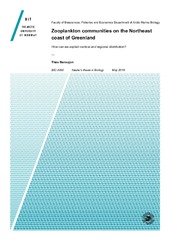Browsing Institutt for arktisk og marin biologi by Title
Now showing items 1880-1891 of 1891
-
Year-round CH4 and CO2 flux dynamics in two contrasting freshwater ecosystems of the subarctic
(Journal article; Tidsskriftartikkel; Peer reviewed, 2017-11-21)Lakes and wetlands, common ecosystems of the high northern latitudes, exchange large amounts of the climate-forcing gases methane (CH4) and carbon dioxide (CO2) with the atmosphere. The magnitudes of these fluxes and the processes driving them are still uncertain, particularly for subarctic and Arctic lakes where direct measurements of CH4 and CO2 emissions are often of low temporal resolution and ... -
Year-round distribution of Northeast Atlantic seabird populations: applications for population management and marine spatial planning
(Journal article; Tidsskriftartikkel; Peer reviewed, 2021)Tracking data of marine predators are increasingly used in marine spatial management. We developed a spatial data set with estimates of the monthly distribution of 6 pelagic seabird species breeding in the Northeast Atlantic. The data set was based on year-round global location sensor (GLS) tracking data of 2356 adult seabirds from 2006−2019 from a network of seabird colonies, data describing the ... -
Yearly variation in allelopathic compound production along a climatic gradient. A case of study of Empetrum nigrum
(Master thesis; Mastergradsoppgave, 2017-11-15)Empetrum nigrum is a plant common in northern ecosystems with capacity to produce allelopathic compounds, which among other effects inhibit seed establishment and germination of other plants. Some of the most studied compounds regarding this effect are batatasin-III and phenolic acids, among them caffeic acid, which account for a large proportion of the leaf’s biomass. 5 random sites were established ... -
You are what you eat: Following fats through food chains
(Journal article; Tidsskriftartikkel, 2010) -
Zooplankton and sediment fluxes in two contrasting fjords reveal Atlantification of the Arctic
(Journal article; Tidsskriftartikkel; Peer reviewed, 2021-02-04)Svalbard fjords are facing a significant increase in Atlantic water inflow, which influences all ecosystem components, thus the objective of this study was to assess how recent Atlantification impacts the functioning of zooplankton community. For this purpose, two year-round operating sediment traps and associated hydrographic instruments, providing continuous time series of zooplankton and sediment ... -
Zooplankton communities associated with new and regenerated primary production in the Atlantic inflow north of Svalbard
(Journal article; Tidsskriftartikkel; Peer reviewed, 2019-06-05)The Arctic Ocean is changing rapidly with respect to ice cover extent and volume, growth season duration and biological production. Zooplankton are important components in the arctic marine food web, and tightly coupled to the strong seasonality in primary production. In this study, we investigate zooplankton composition, including microzooplankton, copepod nauplii, as well as small and large copepod ... -
Zooplankton communities on the Northeast coast of Greenland. How can we explain vertical and regional distribution?
(Master thesis; Mastergradsoppgave, 2019-05-16)Most studies on zooplankton investigate the famous, and omnipresent, Calanoid copepods Calanus spp., because they are abundant, and constitute the major trophic link in marine ecosystems. Indeed, Northeast Greenland is located on the crossroad of Arctic and Atlantic waters which, potentially, can lead to a high biodiversity originating from different domains of marine life. However, there are very ... -
Zooplankton excretion metabolites stimulate Southern Ocean phytoplankton growth
(Journal article; Tidsskriftartikkel; Peer reviewed, 2017-04-24)Warming over Antarctica is leading to changes in the zooplankton communities inhabiting the Southern Ocean. It has been observed that zooplankton not only regulates phytoplankton through grazing, but also through the recycling of nutrients that are essential for phytoplankton growth. In this way, the effects of warming on zooplankton populations will change the amount or proportion at which recycled ... -
Økologiske konsekvenser av restaurering av elveforbygninger og avsnørte meandre ved Bones, Salangselva. Sluttrapport 2003-2009
(Research report; Forskningsrapport, 2010-04)I 2006 og 2007 ble deler av de eldre elveforbygningene ved Bones i Salangselva i Troms restaurert. Et eldre elveløp samt et større meander ble igjen åpnet for vann-gjennomstrømning samt at det ble gjennomført flere mindre justeringer på det gam-le inngrepet. NINA og Akvaplan-niva ble engasjert av NVE for å vurdere eventuelle miljøeffekter av restaureringstiltaket. Det ble gjennomført for- og ... -
Økologiske kriterier for en bærekraftig forvaltning av reindriften
(Master thesis; Mastergradsoppgave, 2008-11)Reindrifta i Vest-Finnmark er for tiden inne i en prosess der økologiske kriterier for en bærekraftig forvaltning skal identifiseres. Formålet med denne oppgaven var å undersøke hvilke kriterier som kan egne seg som effektive, rettferdige og legitime standarder for fastsettelse av høyeste reintall. Jeg baserer meg på kvalitative intervjuer av reineiere og dokumentanalyse av reindriftsforvaltningens ... -
Økt kunnskap om økologisk tunnelproduksjon av bær. Sorter, gjødsling, dyrkingsteknikk
(Research report; Forskningsrapport, 2021-04-16)Bærproduksjon i plasttunnel har blitt trukket frem som en løsning for økologisk bærdyrking. Et slikt produksjonssystem er relativt nytt i Norge, og det er behov for mer kunnskap for å optimalisere produksjonen. I perioden 2017-2019 har vi gjennom prosjektet “Økologisk tunnelbær og flytende næring”, finansiert av Kunnskapsutviklingsmidler for økologisk produksjon i NIBIO, hatt ulike forsøk ved ... -
Ørekyt i Namsenvassdraget. Utbredelse, spredningsrisiko og tiltak
(Research report; Forskningsrapport, 2006-04)Undersøkelser i Namsenvassdraget i 2005 viste at ørekyt forekommer i tette bestander i innsjøer og flyer øverst i vassdraget. I Otersjøen øverst i Sanddøla har ørekyt forekommet i solide bestander siden 1960-tallet. I Tunnsjøen og i Namsvatnet ble arten først registrert på 1990-tallet. Kartleggingen i 2005 viste at ørekyt hadde spredt seg fra Tunnsjøen til Tunnsjøflyan, men ikke videre ned ...


 English
English norsk
norsk










